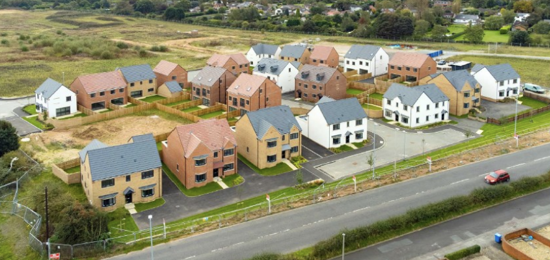5 Top Tips for financing an Office-to-Resi conversion
Office-to-residential conversions have become a vital tool in addressing the UK’s housing shortage. Since 2015, nearly 96,000 homes have been delivered through office-to-resi schemes under permitted development (PD) rights*— a figure set to grow now that the 1,500m² size cap has been lifted, opening the door to larger-scale conversions.
For developers, PD offers a faster, more flexible route to repurpose underused commercial buildings. Unlike standard planning permission — which typically requires that you start development by a given date — permitted development requires that you complete the works within a specific timeframe (usually 3 years from prior approval). That makes efficient delivery, and well-structured finance, even more critical.
However, PD is not without limits. Some areas are designated under Article 4 directions, which remove permitted development rights — particularly in places where local authorities want to protect commercial space. Developers should always check whether a target site falls within an Article 4 zone, as this would trigger the need for full planning permission.
It’s also important to note that permitted development rights typically apply to internal works only. If external alterations are proposed — such as upgrading windows, installing vents, or improving the building’s façade — a separate full planning application is usually required. These applications are often straightforward, but they can add time and complexity to the procurement process if not accounted for early on.
In a landscape shaped by policy reform, regulatory bottlenecks, and market variability, getting the finance right is essential. Below, we share five insights to help developers and brokers structure funding for office-to-resi conversions with confidence.
1. Permitted development is fast — but your finance must be faster
One of PD’s key benefits is speed. Prior approval is typically secured in just 56 days — significantly faster than a full planning route. That makes permitted development ideal for developers who can move quickly on acquisitions.
But in today’s competitive environment, many developers risk missing out simply because finance can’t be arranged in time. Recent data shows that between March and November 2024, office-to-resi applications in London rose by 58% compared with the same period in 2019 — a clear sign that competition for viable buildings is intensifying.
This is where bridging-to-development loan structures become invaluable. A short-term bridge facility enables fast acquisition, followed by a tailored development loan once conditions are in place. It’s an increasingly popular approach — and often essential for securing high-potential buildings that attract multiple bidders.
*zurich.co.uk
Another reason this structure works well for PD is that projects tend to be equity-intensive upfront, due to the cost of acquiring the donor building. At Atelier, we often fund up to 90% LTV on day one, helping developers minimise the amount of equity they need to commit at the outset. That early capital efficiency can be the difference between winning or losing the site — especially in a competitive bid scenario.
2. Understand what the building offers — and what it doesn’t
Not every office building makes a good candidate for conversion. Floorplate depth, access to natural light, ceiling heights, and structural layout all affect how easily — and cost-effectively — a commercial building can be adapted into homes.
Many of the best PD opportunities are found in lower-rise, post-war office buildings in commuter towns such as Basingstoke, Hayes, and Reading — typically close to transport links and with layouts that lend themselves to residential use.
Office-to-residential conversions can also present an opportunity to explore upward extensions — subject to prior approval from the local planning authority. However, it's important to note that once a building has been converted to residential under permitted development, further development such as adding additional floors typically falls outside PD rights and would require full planning permission.
It’s also worth remembering that PD schemes are still subject to the Building Safety Act. This means any building over 18 metres in height will trigger Gateway 2 — introducing additional regulatory checks and potential delays. That said, many PD opportunities involve buildings under 18m, where Gateway 2 does not apply — making them more straightforward to progress from both a design and finance perspective.
3. Design and quality matters — even when planning isn’t required
Permitted development removes the need for full planning permission, but it doesn't eliminate design and compliance obligations. Since 2021, all new homes created via PD must meet national space standards and provide adequate natural light. Local authorities are applying greater scrutiny at the prior approval stage — and lenders are equally focused on ensuring schemes are compliant, buildable, and likely to appeal at exit.
High-quality PD schemes — with well-sized units, thoughtful layouts and a strong design strategy — are more likely to secure prior approval and achieve stronger values at exit.
From a construction perspective, many commercial buildings make excellent donor structures: they often offer high ceilings, robust soundproofing, and a blank canvas floorplate. This gives developers the flexibility to design modern, market-ready accommodation with the ideal mix of one-, two- and three-bedroom units.
There’s also often potential to create on-site amenity space — which is increasingly important to buyers and renters, particularly in urban areas. And from a buildability standpoint, PD projects come with another key advantage: the structure is already wind- and watertight from day one. That means the programme is less exposed to weather delays or unknowns below ground, improving delivery certainty.
In an increasingly competitive market, build quality and design are key differentiators. Aesthetics and kerb appeal really matter too. If you're aiming for strong sales values, the building needs to look and feel residential — not like a converted office. If the site is constrained and limits the ability to transform its external appearance, it may be more commercially viable to focus on rental units, where value is driven more by yield than façade.
Today, both developers and lenders are assessing design feasibility much earlier in the process. A lender with conversion experience can help sense-check assumptions around layout, cost and exit value — often before terms are agreed.
4. Location, location, location
The location of a permitted development opportunity is just as critical as the building itself. Many of the most successful office-to-residential conversions are found in central town or city locations, often with existing car parking and strong public transport links — features that offer a genuine advantage over many new-build sites.
That central positioning not only supports buyer and tenant demand, but can also reduce the need for costly infrastructure improvements. However, not all PD opportunities are created equal. There are plenty of former office buildings in secondary and tertiary locations, where demand is weaker and resale or rental values may not justify the investment.
In these cases, it’s essential to build a compelling business case. A well-priced site in a secondary location can still work — but only if the local market fundamentals, design quality, and exit strategy are strong and well thought through.
5. Plan for your exit — and be realistic about sales and lettings
PD conversions are often quicker to deliver than ground-up schemes, with shorter construction programmes and fewer pre-start conditions. But the real pressure point comes at exit — whether that’s unit sales, PRS disposal or refinance.
In towns with strong fundamentals — e.g. good schools, fast rail links, local employment — converted residential stock can achieve strong sales rates. But overestimating values or demand can put both the project and the funding at risk.
With interest rates still elevated and residential demand varying across regions, lenders are placing increased emphasis on exit strategy and local market evidence. Developers should work backwards from exit values — ensuring that assumptions are underpinned by comparable sales, early agent input, and real-world demand.
In conclusion
Permitted development continues to be one of the most active — and fastest evolving areas in UK real estate. It offers real opportunity for SME developers who can identify the right buildings and execute efficiently.
It’s often portrayed as a simplified development route — but that doesn’t mean it’s without complexity. Many schemes involve structural alterations, phasing, or additional planning applications (e.g. to add extra units or improve layouts).
Standard finance products may struggle to reflect these variables — particularly where acquisition speed, structural works, or phased delivery are involved.
For developers operating in the permitted development space, securing the right funding partner — one with the flexibility and expertise to navigate planning nuance, build complexity and tight timeframes — can make the difference between a stalled scheme and a successful exit.


